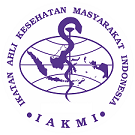Meta-Analysis: Effectiveness of mHealth Utilization on Antenatal Care
DOI:
https://doi.org/10.26911/thejhpm.2024.09.03.10Abstract
Background: An antenatal visit is the presence of pregnant women at health facilities to check their pregnancy and get information about their pregnancy. The use of mobile health interventions (mHealth) such as SMS, voice messages, videos, and interactive mobile phones can provide behavioral support and health education needs of pregnant women. This study aims to determine the effectiveness of the use of mHealth on the improvement of antenatal visits.
Subject and Method: Systematic reviews and meta-analyses were conducted using PRISMA guidelines and PICO models which included Population = pregnant women; Intervention= mHealth, Comparison= does not use mHealth; Outcome= antenatal visit. Articles are collected through databases such as Google Scholar, PubMed, BMJ, Plos One, Plos Digital Health, JMIR, JPHIA, HSPRJ, JIO, Journal of Midwifery and Traditional Health. Keywords used: mHealth or Telemedicine or Phone or Mobile Phones or Mobile Telephone or Short Message Service or Whatsapp Group, Antenatal Visite or Antenatal Care or Pregnancy or Pregnant or Prenatal or Mother Health. A total of 13 articles that met the inclusion criteria were meta-analyzed and assessed using RevMan 5.3.
Results: Meta-analyses from Tanzania, Kenya, India, Brazil, Peru, Bangladesh, Nigeria, Uganda, and Indonesia showed that pregnant women who used mHealth services were 2.94 times more likely to have antenatal visits compared to not using mHealth and the effect was statistically significant (OR= 2.94; CI95%= 2.19 to 3.94; p <0.001).
Conclusion: The use of mHealth may increase antenatal visits.
Keywords:
mHealth, antenatal visits, meta-analysisReferences
Agarwal S, LeFevre AE, Lee J, L'Engle K, Mehl G, Sinha C, Labrique A (2016). Guidelines for reporting of health interventions using mobile phones: mobile health (mHealth) evidence reporting and assessment (mERA) checklist reporting of mobile health (mHealth). BMJ: 1–10. https://doi.-org/10.1136/bmj.i1174.
Ardiyanti S, Mufdlilah, Kusumawati W, Nugroho WS (2020). Whatsapp group increase antenatal visit. Int. J. Health Science and Technology 2(1): 1–6. https://doi.org/-10.31101/-ijhst.v2i1.1817.
Atukunda EC, Siedner MJ, Obua C, Musii-menta A, Ware NC, Mugisha S, Najjuma JN, et al. (2023). Evaluating the feasibility, acceptability, and preliminary efficacy of SupportMoms-Uganda, an mHealth-based patient-centered social support intervention to improve the use of maternity services among pregnant women in rural southwestern Uganda: rando-mized controlled trial. JMIR Formative Research 7: 1–18. https://formative.jmir.org/2023/1/e36619
Bangal VB, Borawake SK, Gavhane SP, Aher KH (2017). Use of mobile phone for improvement in maternal health: a randomized control trial. Int J Reprod Contracept Obstet Gynecol 6(12): 5458. http://dx.doi.org/10.18203/-23201770.-ijrcog20175260.
Benski AC, Schmidt NC, Viviano M, Stan-canelli G, Soaroby A, Reich MR (2020). Improving the quality of antenatal care using mobile health in Madagascar: a cross-sectional study over 5 years. JMIR mHealth and uHealth 8(7): e18543. Doi:10.2196/18543
Chen H, Chai Y, Dong L, Niu W, Zhang P. Effectiveness and appropriateness of mHealth interventions for maternal and child health: systematic review. JMIR mHealth Uhealth. 6(1):e7. doi:10.2196/jmir.1923.
Coleman J, Black V, Thorson AE, Eriksen J (2020). Evaluating the effect of maternal mHealth text messages on uptake of maternal and child health care services in South Africa: a multicentre cohort intervention study. BMC Reprod Health 17: 160 https://doi.org/10.1186/s12978-020-01017-3
Fedha T (2014). Impact of mobile telephone on maternal health service care: a case of Njoro Division. Open J. Preventive Medicine 4(5): 365–76. http://dx.doi.org/10.-4236/ojpm.-2014.45044.
Garcia PJ, Perez-Lu J, Curioso WH, Carcamo CP, Beuermann D (2021). WAWARED: Getting connected using mobile technologies for better maternal and child health in Peru: a randomized controlled trial. Health Sys Policy Res: 1–7 www.imedpub.com
Kemenkes RI. (2021). Profil kesehatan Indonesia. Retrieved: October 29, 2022, from http://www.kemkes/go.id.
Lund S, Nielsen BB, Hemed M, Boas IM, Said A, Said K, Makungu MH, et al (2014). Mobile phones improve antenatal care attendance in Zanzibar: a cluster randomized controlled trial. BMC pregnancy and childbirth 14: 29. http://www.biomedcentral-.com/1-471-2393/-14/29.
Masoi TJ, Kibusi SM, Bintabara D, Lilungulu A (2023). The effectiveness of interactive mobile health technologies in improving antenatal care service utilization in Dodoma region, Tanzania: A quasi-Experimental Study. Plos Digit Health 2(8): e0000321. https://doi.org/10.1371/journal.pdig.000-0321.
Murthy N, Chandrasekharan S, Prakash MP, Ganju A, Peter J, Kaonga N, Mechael P (2020). Effects of an mHealth voice message service (mMitra) on maternal health knowledge and practices of low-income women in India: Findings from a pseudo-randomized controlled trial. BMC Public Health 20(1): 1–10. https://doi.org/10.1186-/s12889-020-08965-2.
National Population Commission (2018). Nigeria Demographic and Health Survey 2018. Retrieved August 30, 2023 from https://dhsprogram.com/pubs/-pdf/FR359/FR359.pdf
Oliveira-Ciabati L, Vieira CS, Franzon ACA, Alves D, Zaratini FS, Braga GC, Sanchez JAC, et al (2017). PRENACEL - a mHealth messaging system to complement antenatal care: a cluster randomized trial. Reproductive Health 14(1): 1–12. https://doi.org/10.1186/s-12978-017-0407-1.
Osanyin GE, Bankethomas A, Oluwole EO, Odeseye AK, Afalobi BB (2022). Effects of a mHealth voice messaging intervention on antenatal care utilisation at primary care level in Lagos, Nigeria : a cluster randomised trial. Public Health J Africa 13(3): 1–11. https://doi.org/10.4081/jphia.-2022.2222.
Oyeyemi MO, Wynn R (2014). Giving cell phones to pregnant women and improving services may increase primary health facility utilization: a case–control study of a Nigerian project. BMC Reprod Health 11:8. DOI: 10.1186/1742-4755-11-8.
Sari EM, Rohmin A, Hariani D, Syafriani EI (2023). Pengaruh pemanfaatan short message service (SMS) terhadap kepatuhan kunjungan antenatal care pada ibu hamil di rumah bersalin Mitra Ananda Palembang (The effect of the use of short message service (SMS) on the compliance of antenatal care visits for pregnant women at the Mitra Ananda Palembang maternity home). J. Ilmiah Obsgin. 15(2): 405-411. https://doi.org/10.36089/job.v15i2.-1293.
Shiferaw S, Spigt M, Tekei M, Abdullah M, Fantahun M, Dinant G-J (2016). The effects of a locally developed mHealth intervention on delivery and postnatal care utilization; a prospective controlled evaluation among health centres in Ethiopia. Plos One 11(7): e0158600. Doi: 10.1371/journal.pone.0158600.
Song H, May A, Vaidhyanathan V, Cramer EM, Owais RW, McRoy S (2013). A two-way text-messaging system answering health questions for low-income pregnant women. Elsevier. 92(2): 182-187. https://doi.org/-10.1016/j.-pec.2013.04.016
Tanzania Demographic and Health Survey (2022). Tanzania demographic and health survey and malaria indicator survey 2022. Retrieved September 27, 2023 from https://dhsprogram.-com/pubs/pdf/PR144/PPR144.pdf
Tobe RG, Haque SE, Mubassara S, Rahman R, Ikegami K, Mori R (2022). Maternal and Child Health Handbook to Improve Continuum of Maternal and Child Care in Rural Bangladesh: Findings of a Cluster Randomized Controlled Trial. PLoS ONE 17(4 April): 1–16. http://doi.org/10.1371/journal.pone.0266074
Uganda Bureau of Statistics (2016). Uganda demographic and health survey 2016. Udhs: 625. www.DHSprogram.com.
Ummah DA, Kostania G, Rosalinna (2020). Reminder Dengan Short Message Service (SMS) Untuk Meningkatkan Kepatuhan Kunjungan K4 Dan Kemampuan Deteksi Dini Tanda Bahaya Ibu Hamil Trimester III (Reminder with Short Message Service (SMS) to Improve K4 Visit Compliance and Early Detection Ability of Danger Signs of Pregnant Women in the Third Trimester). Kebidanan dan Kesehatan J Tradisional 5(2): 94–103. https://doi.org/10.-37341/jk-kt.v5i2.146.
Wagnew F, Dessie G, Alebel A, Mulugeta H, Belay YA, Abajobir AA. Does short message service improve focused antenatal care visit and skilled birth attendance? A systematic review and meta-analysis of randomized clinical trials. Reprod Health. 2023 October 14;15 (1):191. doi: 10.1186/s12978-018-0635-z. https://reproductive-health-juornal.biomedcentral.com/-articles/10.1186/s12978-018-0635-z.
World Health Organization (2018). WHO recommendation on antenatal care for a positive pregnancy experience: summary. Retrieved August 29, 2023 from https://iris.who.-int/bit-stream/-handle/10665/259947/WHO-RHR-18.02eng.-pdf
World Health Organization Statistics (2018). Transcommunication World Health Statistics. Retrieved September 19, 2023 from https://www.who.int/docs/-default-source/gho-documents-/world-health-statistic-reports/6-june-18108-world-health-statistics-2018.pdf
World Health Organization (2019). Trends in Maternal Mortality: 2000–2017—Estimates by WHO, UNICEF, UNFPA, World Bank Group and the United Nations Population Division. Retrieved October,13 2023 from: https://www.unfpa.org/-featured-publication/trends-maternal-mortality-2000-2017.
Yayasan Karya Sains. (2023). Penilaian Kritis (Critical Appraisal) Studi Randomized Controlled Trial (RCT) untuk Penelitian Meta-analisis. Program Studi Magister Ilmu Kesehatan Masyarakat, Sekolah Pascasarjana, Universitas Sebelas Maret.




